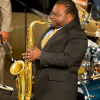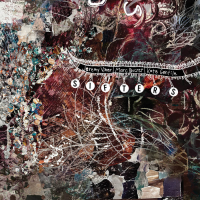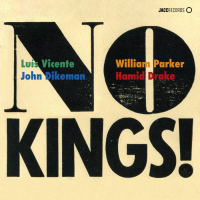Home » Jazz Articles » Album Review » Anthony E. Nelson Jr.: Swinging Sunset
Anthony E. Nelson Jr.: Swinging Sunset
The opening track is "Canadian Sunset" composed by Eddie Heywood Jr. There is no evidence that Heywood ever visited Canada and accordingly never saw a sunset there. Nevertheless, the song became a popular favorite and peaked at No. 2 on the Billboard Charts in 1956. The piece percolates along in jocular style with Nelson demonstrating a clean tone and unwavering technique. Koehler digs out the good stuff on the B3, with stellar ride-cymbal time-keeping from Brooks. Nelson wrote "Uno Mas Por Roberto" for his Spanish speaking uncle Bob. This bossa-soul chart was written for one of Nelson's favorite tenor saxophonists Johnny Griffin. The arrangement touches all the appropriate bases with the precisely calibrated rhythms established by Brooks. Nelson and Koehler showing a keen sense of collaboration as they spin out the number.
Tenor saxophonist Stanley Turrentine spent many years working with organists such as Shirley Scott and Jimmy Smith, and so he was immersed in that combo style. His number "Minor Chant" was written for Smith's 1960 release Back at the Chicken Shack. This funky soul blowing-session from Nelson stays close to Turrentine's intent with the number; all the while Koehler's B3 efforts ripple ahead, covering all the corners of the rendition. One of the signs of a fully formed tenor saxophonist is the capability to show sensitivity on slower tempos. There are two perfect examples on which Nelson can demonstrate this capacity, firstly "Why Did I Chose You" and then Tadd Dameron's classic "On A Misty Night." Supported by the rich voicing from Koehler's organ, Nelson covers the numbers with sensitivity, subtlety, and curiosity.
The album closes with another Nelson original "Last Call ( for Gryce)" written for tenor saxophonist Tommy Gryce. This is a slow blues done in a soulful and expressive style with both Nelson and Koehler digging in with solos which are sonorous, warm, and alert.
Track Listing
Canadian Sunset; One More Once; Girl Talk; Una Mas Por Roberto; These Foolish Things; Minor Chant; Mildew; Why Did I Choose You; On A Misty Night; Three Little Words; Walk With Me; Last Call.
Personnel
Album information
Title: Swinging Sunset | Year Released: 2023 | Record Label: Musicstand
Tags
About Anthony E. Nelson Jr.
Instrument: Saxophone, tenor
PREVIOUS / NEXT
Support All About Jazz
 All About Jazz has been a pillar of jazz since 1995, championing it as an art form and, more importantly, supporting the musicians who make it. Our enduring commitment has made "AAJ" one of the most culturally important websites of its kind, read by hundreds of thousands of fans, musicians and industry figures every month.
All About Jazz has been a pillar of jazz since 1995, championing it as an art form and, more importantly, supporting the musicians who make it. Our enduring commitment has made "AAJ" one of the most culturally important websites of its kind, read by hundreds of thousands of fans, musicians and industry figures every month.






















